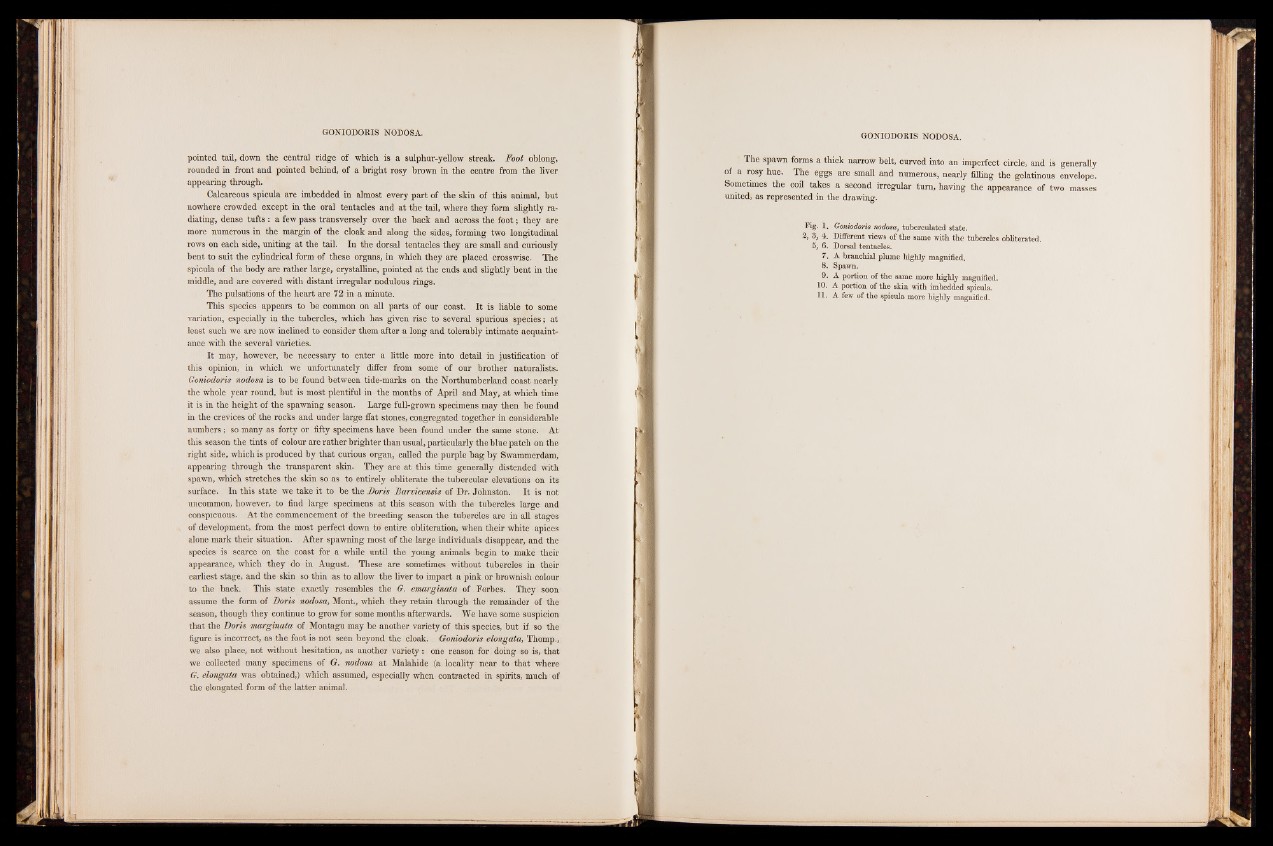
GONIODORIS NODOSA.
pointed tail, down the central ridge of which is a sulphur-yellow streak. Foot oblong,
rounded in front and pointed behind, of a bright rosy brown in the centre from the liver
appearing through.
Calcareous spicula are imbedded in almost every part of the skin of this animal, but
nowhere crowded except in the oral tentacles and at the tail, where they form slightly radiating,
dense tufts : a few pass transversely over the back and across the foot; they are
more numerous in the margin of the cloak and along the sides, forming two longitudinal
rows on each side, uniting at the tail. In the dorsal tentacles they are small and curiously
bent to suit the cylindrical form of these organs, in which they are placed crosswise. The
spicula of the body are rather large, crystalline, pointed at the ends and slightly bent in the
middle, and are covered with distant irregular nodulous rings.
The pulsations of the heart are 72 in a minute.
This species appears to be common on all parts of our coast. It is liable to some
variation, especially in the tubercles, which has given rise to several spurious species; at
least such we are now inclined to consider them after a long and tolerably intimate acquaintance
with the several varieties.
It may, however, be necessary to enter a little more into detail in justification of
this opinion, in which we unfortunately differ from some of our brother naturalists.
Goniodoris nodosa is to be found between tide-marks on the Northumberland coast nearly
the whole year round, but is most plentiful in the months of April and May, at which time
it is in the height of the spawning season. Large full-grown specimens may then be found
in the crevices of the rocks and under large fiat stones, congregated together in considerable
numbers; so many as forty or fifty specimens have been found under the same stone. At
this season the tints of colour are rather brighter than usual, particularly the blue patch on the
right side, which is produced by that curious organ, called the purple bag by Swammerdam,
appearing through the transparent skin. They are at this time generally distended with
spawn, which stretches the skin so as to entirely obliterate the tubercular elevations on its
surface. In this state we take it to be the JDoris Barvicensis of Dr. Johnston. It is not
uncommon, however, to find large specimens at this season with the tubercles large and
conspicuous. At the commencement of the breeding season the tubercles are in all stages
of development, from the most perfect down to entire obliteration, when their white apices
alone mark their situation. After spawning most of the large individuals disappear, and the
species is scarce on the coast for a while until the young animals begin to make their
appearance, which they do in August. These are sometimes without tubercles in their
earliest stage, and the skin so thin as to allow the liver to impart a pink or brownish colour
to the back. This state exactly resembles the G. emarginata of Forbes. They soon
assume the form of Doris nodosa, Mont., which they retain through the remainder of the
season, though they continue to grow for some months afterwards. We have some suspicion
that the Doris marginata of Montagu may be another variety of this species, but if so the
figure is incorrect, as the foot is not seen beyond the cloak. Goniodoris elongata, Thomp.,
we also place, not without hesitation, as another variety: one reason for doing so is, that
we collected many specimens of G. nodosa at Malahide (a locality near to that where
G. elongata was obtained,) which assumed, especially when contracted in spirits, much' of
the elongated form of the latter animal.
GONIODORIS NODOSA.
The spawn forms a thick narrow belt, curved into an imperfect circle, and is generally
of a rosy hue. The eggs are small and numerous, nearly filling the gelatinous envelope.
Sometimes the coil takes a second irregular turn, having the appearance of two masses
united, as represented in the drawing.
Fig. 1.
2, 3, 4.
5, 6.
7.
8.
10. 11.
Goniodoris nodosa, tuberculated state.
Different views of the same with the tubercles obliterated.
Dorsal tentacles.
A branchial plume highly magnified.
Spawn.
A portion of the same more highly magnified.
A portion of the skin with imbedded spicula.
A few of the spicula more highly magnified.